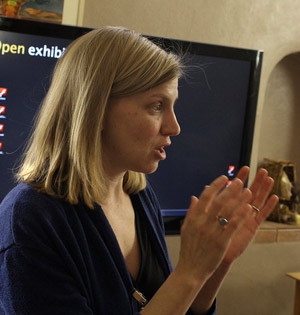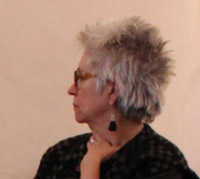Research and evaluation for the Open Exhibits grant project
 During the last session on Thursday, Kate Haley Goldman explored the process of research and evaluation for the Open Exhibits grant project.
During the last session on Thursday, Kate Haley Goldman explored the process of research and evaluation for the Open Exhibits grant project.
Goldman shared three phases of the research process:
- Research literature on best practices – (Currently there’s almost no existing data on the best practices for multimedia in museums)
- Formative evaluation (Creating a set of defined attributes, goals, and theorizing what experiences should feel like)
- Evaluating multimedia interactive environments
When speaking to the National Science Foundation, NSF, Goldman shared her belief that all questions came back to one issue: How do these multimedia exhibits address social interaction? She says, “As NSF pushed us further to look at social interaction, we reminded ourselves that we had to be careful not to design a research study that wasn’t designed to look at this in the first place.” She emphasized that, while social interaction is valuable, the goals of this project are more related to identifying the best way to present the content and exhibits.

 At this point, Kathleen McLean chimed in and shared her observations of visitors’ experiences of multimedia exhibits. “They expect that when they go up to that table, it will offer more for them than they would get at a kiosk”. McLean adds, “Tables are social places that bring people together. When you come to a table, it’s an inherently social event.” She continues, “They expect to be able to go up and do something TOGETHER, not four people leading their own thing.” When people gather around a table, one can expect to play card games, eat dinner, make something, and engage in other group activities.
At this point, Kathleen McLean chimed in and shared her observations of visitors’ experiences of multimedia exhibits. “They expect that when they go up to that table, it will offer more for them than they would get at a kiosk”. McLean adds, “Tables are social places that bring people together. When you come to a table, it’s an inherently social event.” She continues, “They expect to be able to go up and do something TOGETHER, not four people leading their own thing.” When people gather around a table, one can expect to play card games, eat dinner, make something, and engage in other group activities.
Goldman says that the issues discussed at the summit today focused on formative concepts such as: How can we make the user experience more natural? How can we make it more affordable? We also need to be asking how we can improve the learning experiences of exhibits. Saul Rockman expanded on this with reference to one of NSF’s stated goals asking, “Whatever the activity is supposed to do, does it encourage people to follow and pursue careers in science? Does it make them feel part of the experience?”
by Carrie Williar ![]() on March 11, 2011
on March 11, 2011